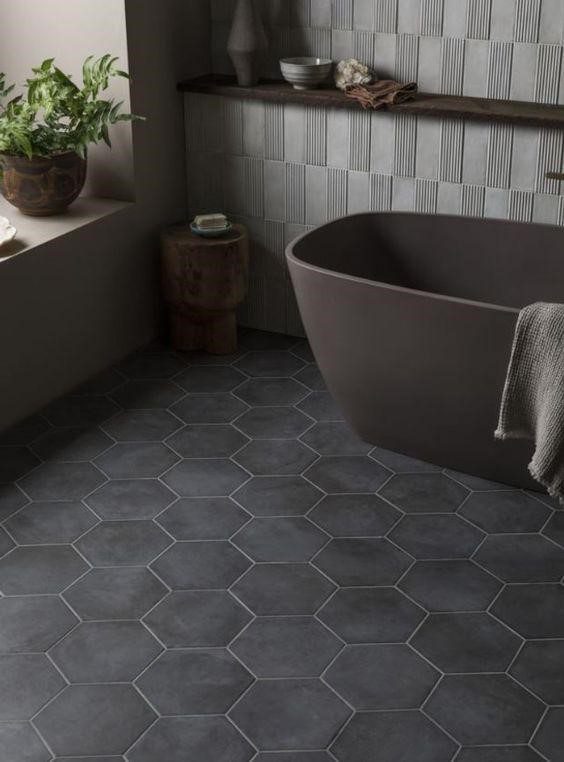A variety of materials are available for bathroom floor tile. Ceramic, porcelain, and vinyl tiles are frequently the first that come to mind: They’re arguably the most practical options available. But today, there are lots of options, like cork and stone. The most crucial points while choosing a flooring material are making sure that it won’t be dangerously sloppy once wet and that moisture won’t seep beneath the surface and cause harm. The final decision usually involves striking a balance between style and price after that. This guide to the best bathroom floor tiles will help you discover all of your alternatives, which will make choices easier.
See also: Bathroom tiles, price per sq ft, tips to choose the best tiles for walls and flooring
8 bathroom floor tiles
01. Vinyl tiles
Due to its low price and great level of functionality, vinyl is the most preferred material for bathroom flooring. Every bathroom in the house, including the master bath and the powder room, can benefit from it. For safety, convenience, and reliability, it outperforms other popular options. Aesthetic appeal and ease of installation have advanced significantly among these tiles. The self-adhering material can be cut with a standard utility knife for easy installation at home.

Source: Pinterest
02. Ceramic mosaic tiles
Whether your preferences are stone or wood imitations, vibrant penny tiles, or squares with lattice patterns, you’re sure to discover that ceramic tile choices are among the best for bathroom floor tile. Ceramics also rank highly in terms of upkeep, although they are not nearly as comfy for bare feet as vinyl. Ceramics are not as simple to install as vinyl, but the brave DIYer can attempt the task. Ceramics will resist wear and scratches when coated with a premium finish.

Source: Pinterest
03. Glass tiles
Two things make glass floor tiles aesthetically pleasing: The appearance of depth and, if coloured, a magnificent stained-glass effect are achieved by covering a portion of the floor in a thin coating of glass. When installed correctly, this sort of tile endures well; however, to avoid slips, choose floor-rated tile and textured glass. Additionally, small glass tiles are slip-resistant and are made with numerous grout joints. With these suggestions in mind, think of decorating a shower floor (and possibly the sides, too) with tiny glass tile squares to add a striking feature to the bathroom.

Source: Pinterest
04. Stone tiles
In the past, the entryway was the only place to find stone tiles. But over the last few years, they have become more common in a variety of spaces, including bathrooms. Stone tiles are made from limestone, marble, granite, and slate and come in a variety of hues, from cream to blues, reds, greens, and gold. Nearly as many different textures are available, including cleft, tumbled, sandblasted, etched, and flamed varieties. Stone often costs more than tiles made of ceramic or porcelain that have a comparable appearance. Additionally, because a genuine stone is more porous than ceramic tile, regular cleaning and sealing are advised.

Source: Pinterest
05. Plastic laminate tiles
Plastic laminate tiles, frequently seen as planks, are also a wonderful option, particularly if you are remodelling. These tiles might function better in a half-bath than a full-bath since standing water might permeate the fiberboard core, causing the material to expand and bend. To prevent water penetration while using laminates, it is essential to caulk any holes along the walls, around the toilet, and (if there is a full bathroom) the tub. Another drawback is that laminates don’t offer the same range of design options as ceramic and vinyl, but still, it is one option to opt for if you don’t want to invest much.

Source: Pinterest
06. Linoleum floor tiles
Linseed oil, cork powder, wood flour, crushed limestone, and colours are the components used to make linoleum tiles. It works well in bathrooms and looks great in modern or vintage settings. It is praised for its ability to naturally resist dirt and dust while also preventing the growth of microbes, all while maintaining its colour. It is simple to install because of the click-in-place plank designs, and there is no denying how fantastic the material looks. Linoleum is relatively expensive, though.

Source: Pinterest
07. Cork tiles
The tiles of cork flooring are coloured in a range of shades and are quite comfortable to walk on. Even if you buy finished tiles, you should expect to apply multiple coats of polyurethane to seal the flooring and keep away moisture from penetrating the subfloor. Glue-down installation is not difficult. Typically, cork tiles are installed with a troweled-on adhesive.

Source: Pinterest
08. Porcelain tiles
Porcelain tiles are among the greatest selections for bathroom floor tile, much as ceramic tiles. Because porcelain tiles have a through-body colour, they may be more durable than clay-based tiles, which is helpful if they chip. Porcelain tiles absorb water at a rate of less than 0.5%, making them water-resistant even though they aren’t entirely waterproof.

Source: Pinterest
FAQs
Which bathroom floor tile is preferable?
Bathrooms are fantastic places for ceramic and porcelain tiles. Tile flooring is durable, waterproof, accessible in a variety of colours and patterns, and typically more affordable than other options.
How durable are bathroom floor tiles?
A tile floor with proper care might easily last 20 years or longer. In reality, a tile floor may last for more than 50 years if the tiles are not permanently damaged in any way.
| Got any questions or point of view on our article? We would love to hear from you.
Write to our Editor-in-Chief Jhumur Ghosh at jhumur.ghosh1@housing.com |






